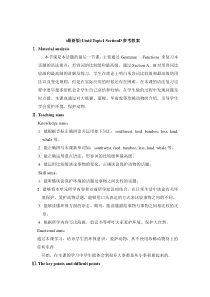 DOC
DOC
【文档说明】Unit 4 Topic 1《Which do you like better,plants or animals》(SectionD)教案-八年级上册英语【仁爱版】.doc,共(9)页,42.000 KB,由小喜鸽上传
转载请保留链接:https://www.ichengzhen.cn/view-104266.html
以下为本文档部分文字说明:
(最新版)Uint4Topic1SectionD参考教案Ⅰ.Materialanalysis本节课是本话题的最后一节课,主要通过Grammar、Functions来复习本话题的语法重点:形容词的比较级和最高级。通过SectionA、B对形容词比较级和最高级的
讲解及练习,学生在理论上明白形容词比较级和最高级的用法以及变化规则,但是在实际应用的时候还存在困难。在本课的语法复习过程中要尽量多给机会让学生自己总结和归纳,在学生做的过程中发现问题及时点拨。本课也通过对大熊猫、蓝
鲸、华南虎等珍稀动物的介绍,引导学生学会爱护环境、保护动物。Ⅱ.TeachingaimsKnowledgeaims:1.能根据音标正确拼读并运用如下词汇:southwest,feed,bamboo,less,land,whale等。2.能正确拼写
本课新单词如:southwest,feed,bamboo,less,land,whale等。3.能正确运用重点语法:形容词的比较级和最高级。4.能运用比较级谈论事物的变化,正确谈论保护动物的话题。Skillaims:1.能听懂谈论保护环境的话题及事物之
间比较的话题。2.能够将本单元所学内容和以前所学知识相结合,在日常生活中谈论有关环境保护、爱护动物话题,能够用口头表达的方式来比较事物之间的不同。3.能够读懂环保方面的杂志、期刊,能读懂描绘事物与事物之间相比较的文章。
4.根据所学内容写出海报,倡议书等呼吁大家爱护环境、保护大自然。Emotionalaims:通过本课学习,培养学生的环保意识,爱护动物,从不使用珍稀动物身上的任何东西开始。在本课的学习中学生能体会到很多大事都是从小事积累起来的。Ⅲ.T
hekeypointsanddifficultpointsKeypoints:1.强化形容词比较级和最高级用法的练习。2.了解珍稀动物濒临灭绝的原因,能用英文发出号召:保护动物。Difficultpoints:形容词的比较级和最高级。Ⅳ.Learningstrategies1.在课前看看1中的三
幅图片,脑袋中回忆一下自己对它们的了解有多少,可以帮助你快速的记忆文章。2.根据自己已有的有关大熊猫、蓝鲸和华南虎的知识,联系课本上的新知识可以让你在课堂上更加集中在你不明白的问题上。Ⅴ.TeachingaidsComputermultimed
iaprojector,somephotosinthezooⅥ.TeachingproceduresStepInteractionpatternStudentactivityTeacheractivityLead-in(8minutes)1.Thewholeclasswork2.Groupw
ork1.Studentsstudytheword“whale”andanswerthequestionswithcomparativeandsuperlativedegreesofadjectives.2.Studentsdiscussthisqu
estioningroups.Studentscangivemanydifferentanswersaccordingtotheirbackgroundknowledge.1.Finish1.Showthreepicturestostudentswhichareta
kenfromzoos,apanda,abluewhale,andaChinesetiger.Teach“whale”hereandask“Whichdoyoulikebetter?”,“Whichdo
youlikebest?”2.Showaquestion:Howmuchdoyouknowaboutthem?Newwordsandsentences(12minutes)3.Thewholeclasswork4.Individualwork5.
Individualworkandgroupwork6.Groupwork3.Studentsstudynewwordseasilyinthecontent.4.Findanswersquickly.Picturesandth
etablecanhelpstudentsalot.5.Retellthepassage.Onestudentretellaparagraph.Groupmemberscanhelphim/herifhe/shecan’tfinishit.6.Studentsf
indtherulesandusageingroups.3.Teacherwritesdownthenewwordsinstudents’answersandteachesthenewwordsatt
histime.4.ShowthetableonPage88tostudents.Remindstudentstolookatthetablecarefully.Infact,withthehelpofthetable,studentscanfind
thecorrectanswersquickly.5.Checktheanswersandguidestudentstoretellthepassagewiththehelpofthetable.6.Writedown“moreandmore/lessandless/
fewerandfewer/betterandbetter”ontheblackboard.Grammar(8minutes)1.Groupwork2.Groupwork3.Individualwork4.Thewholeclasswork1.Studentsdiscus
singroups.Studentsshouldfindoutanimalsindangeratfirst,thenanswerthe4questionsinthetable.2.Studentsdiscussingroups.Studentscangetsom
eideaslike:Weshouldn’tpourdirtywaterintotheriverdirectly.Weshouldplantmoretrees,becausetheycanprovideanimalswithbeautifulh
ome.3.Studentsreporttheirresultswiththehelpofthepaperintheclass.4.Studentsknowsavingisveryimportantandsavepaperfromnowon.1.Showthequestion“Doy
ouknowanyotheranimalsindanger?”ShowthetableinProjecttostudents.Askstudentstocollectinformationingroups.Studentsmayknowsomeanimalsindange
rsuchasgoldenmonkeyandYangtsealligator,buttheydon’tknowhowtoexpressitinEnglish.Teachercanshowthepicturesandwordstohelpstud
ents.2.Askstudentstotalkabouthowtoprotecttheseanimalsandlistthemonapieceofpaper.3.Invitestudentstoreporttheirresultstotheclass.4.Te
acheremphasizestheimportanceofsavinganimals.Remindstudentsnottowastepaperandthepaperonwhichtheylistedthewaystoprotectanimalscanbeusedt
odootherthings.Practice(6minutes)1.Thewholeclassworkandpairwork2.Groupwork3.Groupworkandindividualwork1.Studen
tswritetheirfavoriteanimals.Theymaywriteitbetterwiththehelpofthefollowingquestions:(1)What’stheanimal?(2)Wheredoesitlike?(3)
Whatdoesitfeedon?(4)Whatarethefeaturesofit?(5)Whydoyoulikeit?Handsupwhennecessary.2.Studentsexchangetheirwritingworks.Readt
heirpartners’passagescarefully.Whenreadingothers’,theycanfindsomemistakesinthepassages.Studentsshouldreviseit.3.Twovolunteerssharetheirpassages.Theot
herstudentslistentothemcarefullyandfindthemistakes.1.Finish2.“Justnowwestudieddifferentkindsofanimalsindanger.Weallknowweshouldprotectthem.Therearema
nyotheranimalsthatarenotindanger.Theyarecuteandfriendly.Canyouwriteapassageaboutyourfavoriteanimal?Trytocompareyourfav
oriteanimalwithotheranimals,thenwewillknowwhyyoulikeitbest.”2.Teacherasksstudentstochecktheirwritingworkingroups.3.I
nvitetwovolunteerstosharetheirpassages,andcheckthemistakesinclass.Summary(10minutes)1.Groupwork2.Thewholeclassworkandindividu
alwork3.Individualwork1.Studentsdiscussingroups.Everyonegivestheirownideaaccordingtowhatwelearned.Studentsmakenotesandreadthemqu
ickly.2.Volunteerscometotheplatformonebyone.Allthestudentsgivetheirscores.Inordertomakeiteasy,studentswritedownA,B,CandDaccor
dingtotheirperformances.3.Writeashortpassageandrecorditinarecorder.Studentsshouldpayattentiontothepronunciation.1.Atalkshow.Tomorrowoursch
oolwillselectastudenttotheelementaryschool.Thestudent’staskistogiveareportabouthowtoprotectforestsoranimals.Eachvolunteerhas1min
utetogivethereport.Thebestonecangototheelementaryschool.Providestudentsseveralminutestoprepare.2.Teacherinvitevolunteerstocometotheplatfor
mandrecordthetime.3.Homework:Assignthestudentstowriteapassageabouthowtosavetheanimalsindangerandrecorditinyourtellphoneorrecorder.Bring
ittothenextclass.Payattentiontothepronunciationandintonation.TeachingReflectionThisclassisrelatedtostudents’li
feverymuch.Manystudentslikeanimals.Somepictures,especiallyphotostakeninthezoo,canarousestudents’interest.Studentscantakeanactivepartin
thediscussingaboutsavingtheanimalsindanger.Butwritingashortpassageaboutananimalwithcomparativeorsuperlativedegreesisa
problem.Discussingingroupsaboutthepassagebeforewritingcanhelpstudentsalot.Ⅶ.BlackboarddesignUnit4OurWorldTopic1Whi
chdoyoulikebetter,plantsoranimals?SectionDGrammarmoreandmore/lessandless/fewerandfewer/betterandbetterFunctionsWhichdoyoulikebetter,plants
oranimals?Thatmustbefun!Students’summaryStudents’summary
 辽公网安备 21102102000191号
辽公网安备 21102102000191号
 营业执照
营业执照